Valuation & Performance of Chevron Corp
VerifiedAdded on 2023/06/03
|12
|3089
|97
AI Summary
This study examines the behavior and performance of Chevron's stock performance over different timeframes. Likewise, the causes of changes in stock price as well as their impact on Chevron's profitability will also be examined.
Contribute Materials
Your contribution can guide someone’s learning journey. Share your
documents today.
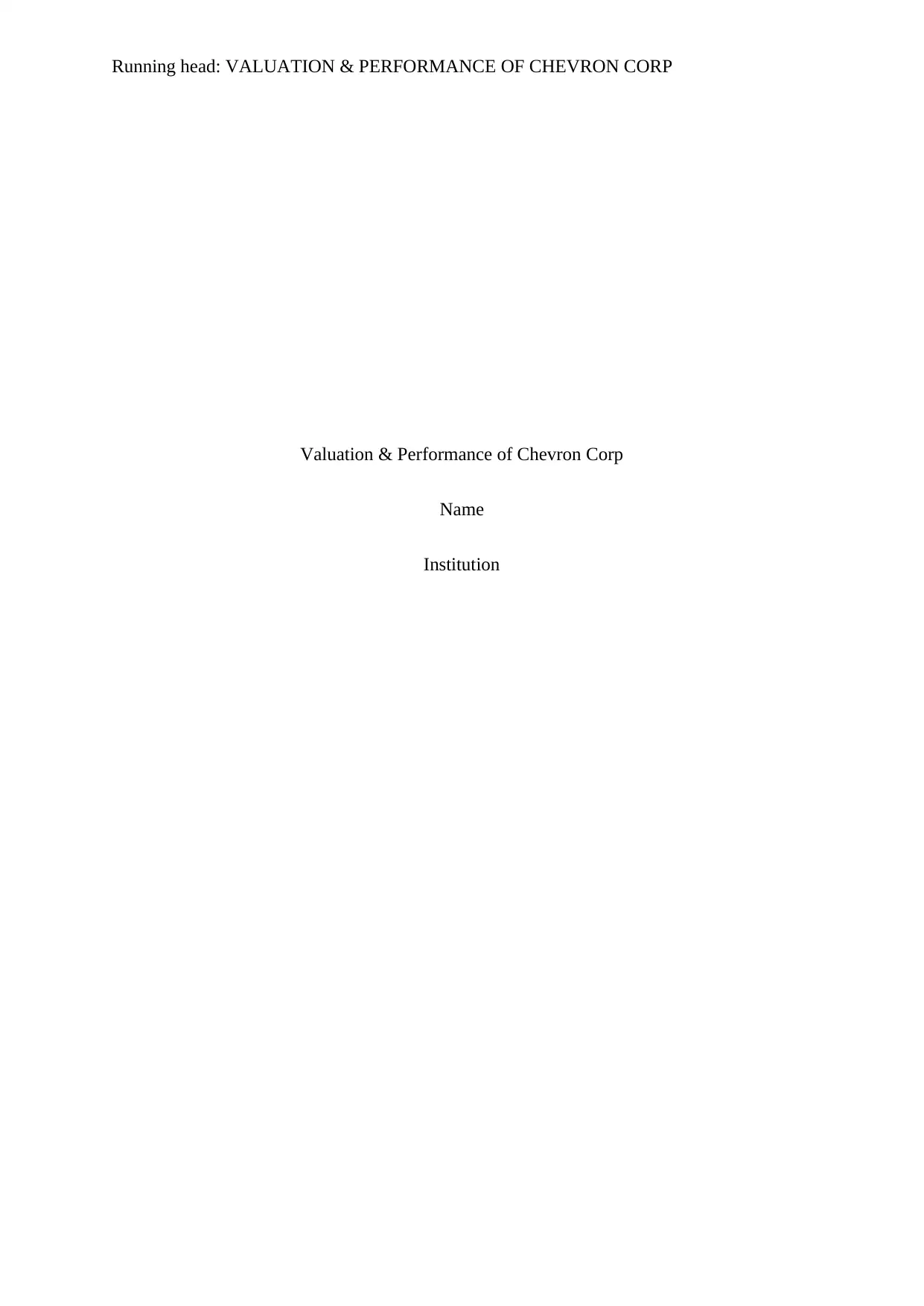
Running head: VALUATION & PERFORMANCE OF CHEVRON CORP
Valuation & Performance of Chevron Corp
Name
Institution
Valuation & Performance of Chevron Corp
Name
Institution
Secure Best Marks with AI Grader
Need help grading? Try our AI Grader for instant feedback on your assignments.

VALUATION & PERFORMANCE OF CHEVRON CORP 2
Introduction
Chevron Corporation was established in 1906 and has its headquarters in San Ramon,
the U.S. the corporation provides financial management, technology, and administrative
services in the U.S. chemical and energy sectors. The operations on the corporation are
categorized into downstream and upstream segments. The downstream segment deals with
refining, marketing, and transporting crude oil and petroleum products. On the other hand,
the upstream segment focuses on exploring, developing, and producing natural gas and crude
oil, liquefying, transporting and regasification of natural gas. The difference between
upstream and downstream segment is that the former focus on international transportation of
crude oil, petroleum products, and natural gases while the latter focus on activities that take
place within a country's jurisdiction.
The volatile nature of the crude oil and petroleum products have a direct impact on the
fluctuation of Chevron's stock value in the market. This study examines the behavior and
performance of the corporation's stock performance over different timeframes. Likewise, the
causes of changes in stock price as well as their impact on Chevron's profitability will also be
examined.
Introduction
Chevron Corporation was established in 1906 and has its headquarters in San Ramon,
the U.S. the corporation provides financial management, technology, and administrative
services in the U.S. chemical and energy sectors. The operations on the corporation are
categorized into downstream and upstream segments. The downstream segment deals with
refining, marketing, and transporting crude oil and petroleum products. On the other hand,
the upstream segment focuses on exploring, developing, and producing natural gas and crude
oil, liquefying, transporting and regasification of natural gas. The difference between
upstream and downstream segment is that the former focus on international transportation of
crude oil, petroleum products, and natural gases while the latter focus on activities that take
place within a country's jurisdiction.
The volatile nature of the crude oil and petroleum products have a direct impact on the
fluctuation of Chevron's stock value in the market. This study examines the behavior and
performance of the corporation's stock performance over different timeframes. Likewise, the
causes of changes in stock price as well as their impact on Chevron's profitability will also be
examined.
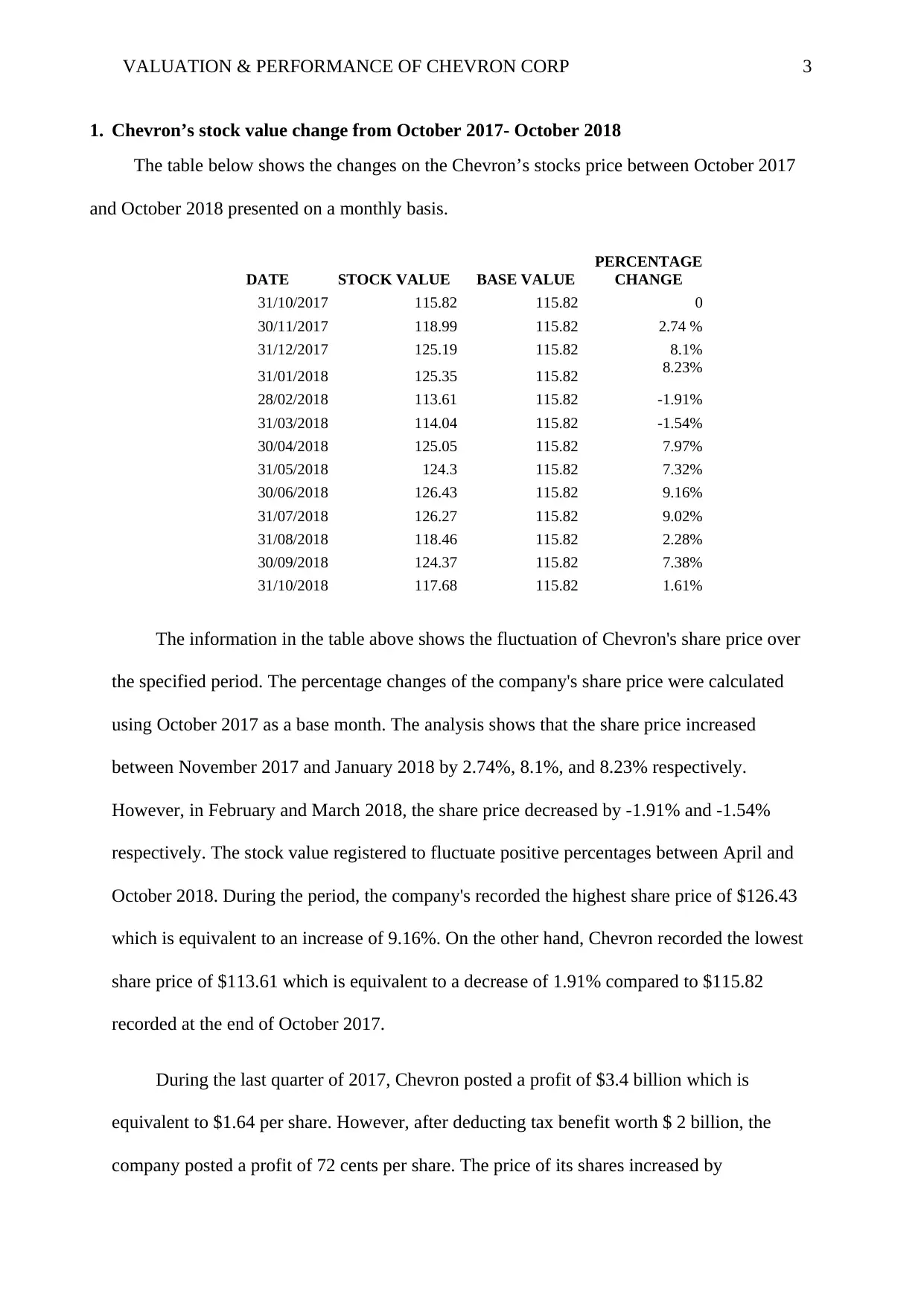
VALUATION & PERFORMANCE OF CHEVRON CORP 3
1. Chevron’s stock value change from October 2017- October 2018
The table below shows the changes on the Chevron’s stocks price between October 2017
and October 2018 presented on a monthly basis.
DATE STOCK VALUE BASE VALUE
PERCENTAGE
CHANGE
31/10/2017 115.82 115.82 0
30/11/2017 118.99 115.82 2.74 %
31/12/2017 125.19 115.82 8.1%
31/01/2018 125.35 115.82 8.23%
28/02/2018 113.61 115.82 -1.91%
31/03/2018 114.04 115.82 -1.54%
30/04/2018 125.05 115.82 7.97%
31/05/2018 124.3 115.82 7.32%
30/06/2018 126.43 115.82 9.16%
31/07/2018 126.27 115.82 9.02%
31/08/2018 118.46 115.82 2.28%
30/09/2018 124.37 115.82 7.38%
31/10/2018 117.68 115.82 1.61%
The information in the table above shows the fluctuation of Chevron's share price over
the specified period. The percentage changes of the company's share price were calculated
using October 2017 as a base month. The analysis shows that the share price increased
between November 2017 and January 2018 by 2.74%, 8.1%, and 8.23% respectively.
However, in February and March 2018, the share price decreased by -1.91% and -1.54%
respectively. The stock value registered to fluctuate positive percentages between April and
October 2018. During the period, the company's recorded the highest share price of $126.43
which is equivalent to an increase of 9.16%. On the other hand, Chevron recorded the lowest
share price of $113.61 which is equivalent to a decrease of 1.91% compared to $115.82
recorded at the end of October 2017.
During the last quarter of 2017, Chevron posted a profit of $3.4 billion which is
equivalent to $1.64 per share. However, after deducting tax benefit worth $ 2 billion, the
company posted a profit of 72 cents per share. The price of its shares increased by
1. Chevron’s stock value change from October 2017- October 2018
The table below shows the changes on the Chevron’s stocks price between October 2017
and October 2018 presented on a monthly basis.
DATE STOCK VALUE BASE VALUE
PERCENTAGE
CHANGE
31/10/2017 115.82 115.82 0
30/11/2017 118.99 115.82 2.74 %
31/12/2017 125.19 115.82 8.1%
31/01/2018 125.35 115.82 8.23%
28/02/2018 113.61 115.82 -1.91%
31/03/2018 114.04 115.82 -1.54%
30/04/2018 125.05 115.82 7.97%
31/05/2018 124.3 115.82 7.32%
30/06/2018 126.43 115.82 9.16%
31/07/2018 126.27 115.82 9.02%
31/08/2018 118.46 115.82 2.28%
30/09/2018 124.37 115.82 7.38%
31/10/2018 117.68 115.82 1.61%
The information in the table above shows the fluctuation of Chevron's share price over
the specified period. The percentage changes of the company's share price were calculated
using October 2017 as a base month. The analysis shows that the share price increased
between November 2017 and January 2018 by 2.74%, 8.1%, and 8.23% respectively.
However, in February and March 2018, the share price decreased by -1.91% and -1.54%
respectively. The stock value registered to fluctuate positive percentages between April and
October 2018. During the period, the company's recorded the highest share price of $126.43
which is equivalent to an increase of 9.16%. On the other hand, Chevron recorded the lowest
share price of $113.61 which is equivalent to a decrease of 1.91% compared to $115.82
recorded at the end of October 2017.
During the last quarter of 2017, Chevron posted a profit of $3.4 billion which is
equivalent to $1.64 per share. However, after deducting tax benefit worth $ 2 billion, the
company posted a profit of 72 cents per share. The price of its shares increased by
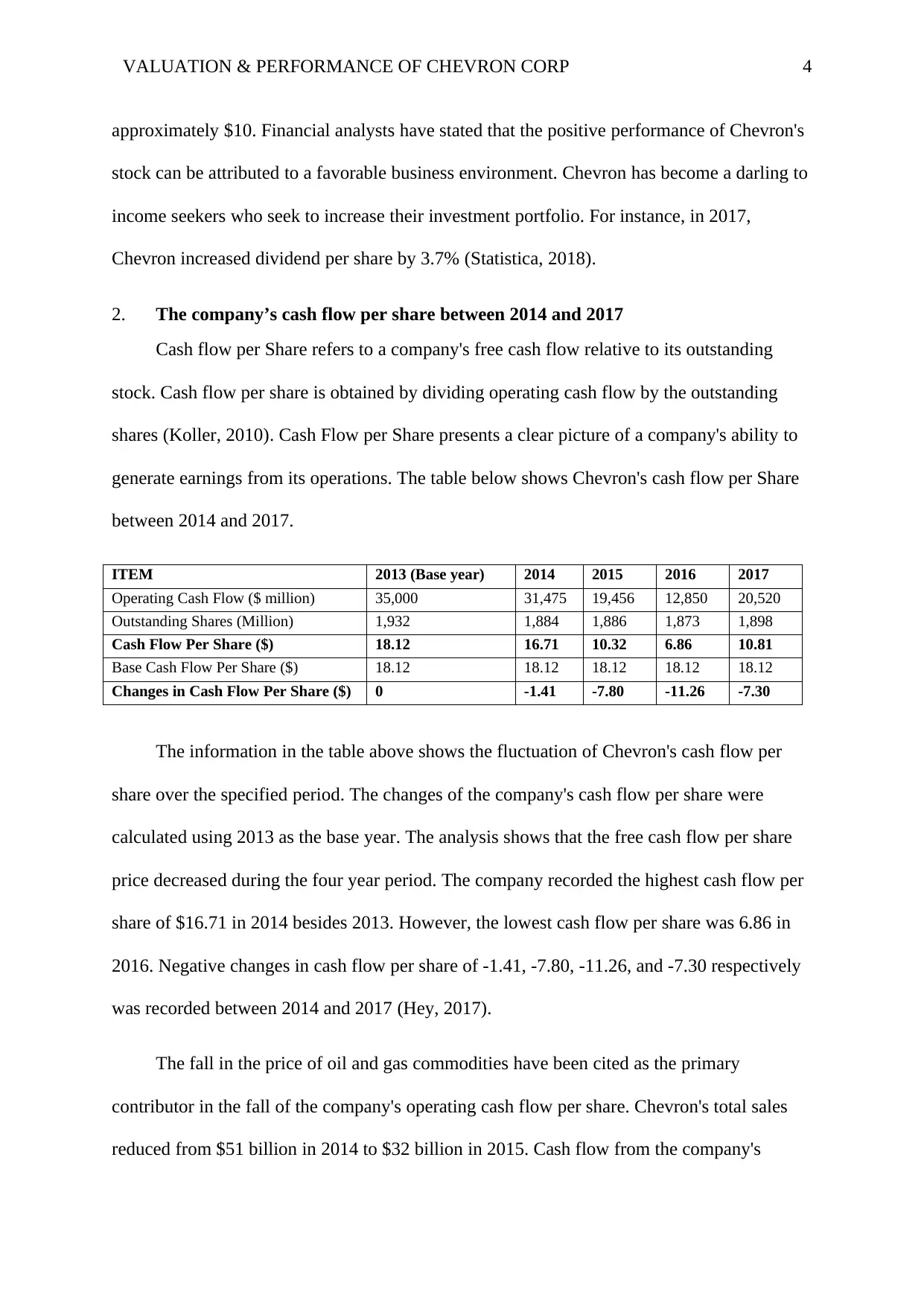
VALUATION & PERFORMANCE OF CHEVRON CORP 4
approximately $10. Financial analysts have stated that the positive performance of Chevron's
stock can be attributed to a favorable business environment. Chevron has become a darling to
income seekers who seek to increase their investment portfolio. For instance, in 2017,
Chevron increased dividend per share by 3.7% (Statistica, 2018).
2. The company’s cash flow per share between 2014 and 2017
Cash flow per Share refers to a company's free cash flow relative to its outstanding
stock. Cash flow per share is obtained by dividing operating cash flow by the outstanding
shares (Koller, 2010). Cash Flow per Share presents a clear picture of a company's ability to
generate earnings from its operations. The table below shows Chevron's cash flow per Share
between 2014 and 2017.
ITEM 2013 (Base year) 2014 2015 2016 2017
Operating Cash Flow ($ million) 35,000 31,475 19,456 12,850 20,520
Outstanding Shares (Million) 1,932 1,884 1,886 1,873 1,898
Cash Flow Per Share ($) 18.12 16.71 10.32 6.86 10.81
Base Cash Flow Per Share ($) 18.12 18.12 18.12 18.12 18.12
Changes in Cash Flow Per Share ($) 0 -1.41 -7.80 -11.26 -7.30
The information in the table above shows the fluctuation of Chevron's cash flow per
share over the specified period. The changes of the company's cash flow per share were
calculated using 2013 as the base year. The analysis shows that the free cash flow per share
price decreased during the four year period. The company recorded the highest cash flow per
share of $16.71 in 2014 besides 2013. However, the lowest cash flow per share was 6.86 in
2016. Negative changes in cash flow per share of -1.41, -7.80, -11.26, and -7.30 respectively
was recorded between 2014 and 2017 (Hey, 2017).
The fall in the price of oil and gas commodities have been cited as the primary
contributor in the fall of the company's operating cash flow per share. Chevron's total sales
reduced from $51 billion in 2014 to $32 billion in 2015. Cash flow from the company's
approximately $10. Financial analysts have stated that the positive performance of Chevron's
stock can be attributed to a favorable business environment. Chevron has become a darling to
income seekers who seek to increase their investment portfolio. For instance, in 2017,
Chevron increased dividend per share by 3.7% (Statistica, 2018).
2. The company’s cash flow per share between 2014 and 2017
Cash flow per Share refers to a company's free cash flow relative to its outstanding
stock. Cash flow per share is obtained by dividing operating cash flow by the outstanding
shares (Koller, 2010). Cash Flow per Share presents a clear picture of a company's ability to
generate earnings from its operations. The table below shows Chevron's cash flow per Share
between 2014 and 2017.
ITEM 2013 (Base year) 2014 2015 2016 2017
Operating Cash Flow ($ million) 35,000 31,475 19,456 12,850 20,520
Outstanding Shares (Million) 1,932 1,884 1,886 1,873 1,898
Cash Flow Per Share ($) 18.12 16.71 10.32 6.86 10.81
Base Cash Flow Per Share ($) 18.12 18.12 18.12 18.12 18.12
Changes in Cash Flow Per Share ($) 0 -1.41 -7.80 -11.26 -7.30
The information in the table above shows the fluctuation of Chevron's cash flow per
share over the specified period. The changes of the company's cash flow per share were
calculated using 2013 as the base year. The analysis shows that the free cash flow per share
price decreased during the four year period. The company recorded the highest cash flow per
share of $16.71 in 2014 besides 2013. However, the lowest cash flow per share was 6.86 in
2016. Negative changes in cash flow per share of -1.41, -7.80, -11.26, and -7.30 respectively
was recorded between 2014 and 2017 (Hey, 2017).
The fall in the price of oil and gas commodities have been cited as the primary
contributor in the fall of the company's operating cash flow per share. Chevron's total sales
reduced from $51 billion in 2014 to $32 billion in 2015. Cash flow from the company's
Secure Best Marks with AI Grader
Need help grading? Try our AI Grader for instant feedback on your assignments.
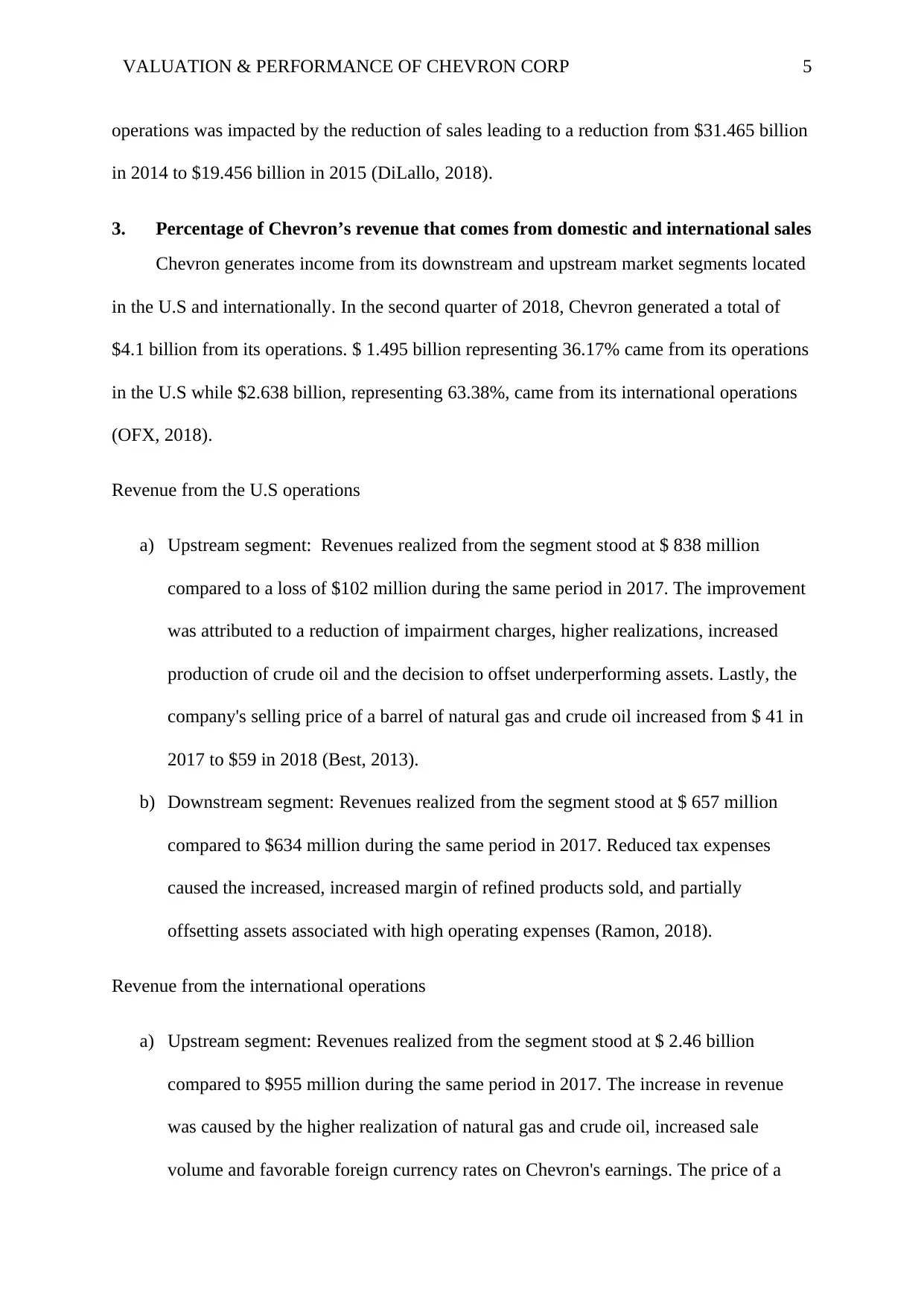
VALUATION & PERFORMANCE OF CHEVRON CORP 5
operations was impacted by the reduction of sales leading to a reduction from $31.465 billion
in 2014 to $19.456 billion in 2015 (DiLallo, 2018).
3. Percentage of Chevron’s revenue that comes from domestic and international sales
Chevron generates income from its downstream and upstream market segments located
in the U.S and internationally. In the second quarter of 2018, Chevron generated a total of
$4.1 billion from its operations. $ 1.495 billion representing 36.17% came from its operations
in the U.S while $2.638 billion, representing 63.38%, came from its international operations
(OFX, 2018).
Revenue from the U.S operations
a) Upstream segment: Revenues realized from the segment stood at $ 838 million
compared to a loss of $102 million during the same period in 2017. The improvement
was attributed to a reduction of impairment charges, higher realizations, increased
production of crude oil and the decision to offset underperforming assets. Lastly, the
company's selling price of a barrel of natural gas and crude oil increased from $ 41 in
2017 to $59 in 2018 (Best, 2013).
b) Downstream segment: Revenues realized from the segment stood at $ 657 million
compared to $634 million during the same period in 2017. Reduced tax expenses
caused the increased, increased margin of refined products sold, and partially
offsetting assets associated with high operating expenses (Ramon, 2018).
Revenue from the international operations
a) Upstream segment: Revenues realized from the segment stood at $ 2.46 billion
compared to $955 million during the same period in 2017. The increase in revenue
was caused by the higher realization of natural gas and crude oil, increased sale
volume and favorable foreign currency rates on Chevron's earnings. The price of a
operations was impacted by the reduction of sales leading to a reduction from $31.465 billion
in 2014 to $19.456 billion in 2015 (DiLallo, 2018).
3. Percentage of Chevron’s revenue that comes from domestic and international sales
Chevron generates income from its downstream and upstream market segments located
in the U.S and internationally. In the second quarter of 2018, Chevron generated a total of
$4.1 billion from its operations. $ 1.495 billion representing 36.17% came from its operations
in the U.S while $2.638 billion, representing 63.38%, came from its international operations
(OFX, 2018).
Revenue from the U.S operations
a) Upstream segment: Revenues realized from the segment stood at $ 838 million
compared to a loss of $102 million during the same period in 2017. The improvement
was attributed to a reduction of impairment charges, higher realizations, increased
production of crude oil and the decision to offset underperforming assets. Lastly, the
company's selling price of a barrel of natural gas and crude oil increased from $ 41 in
2017 to $59 in 2018 (Best, 2013).
b) Downstream segment: Revenues realized from the segment stood at $ 657 million
compared to $634 million during the same period in 2017. Reduced tax expenses
caused the increased, increased margin of refined products sold, and partially
offsetting assets associated with high operating expenses (Ramon, 2018).
Revenue from the international operations
a) Upstream segment: Revenues realized from the segment stood at $ 2.46 billion
compared to $955 million during the same period in 2017. The increase in revenue
was caused by the higher realization of natural gas and crude oil, increased sale
volume and favorable foreign currency rates on Chevron's earnings. The price of a
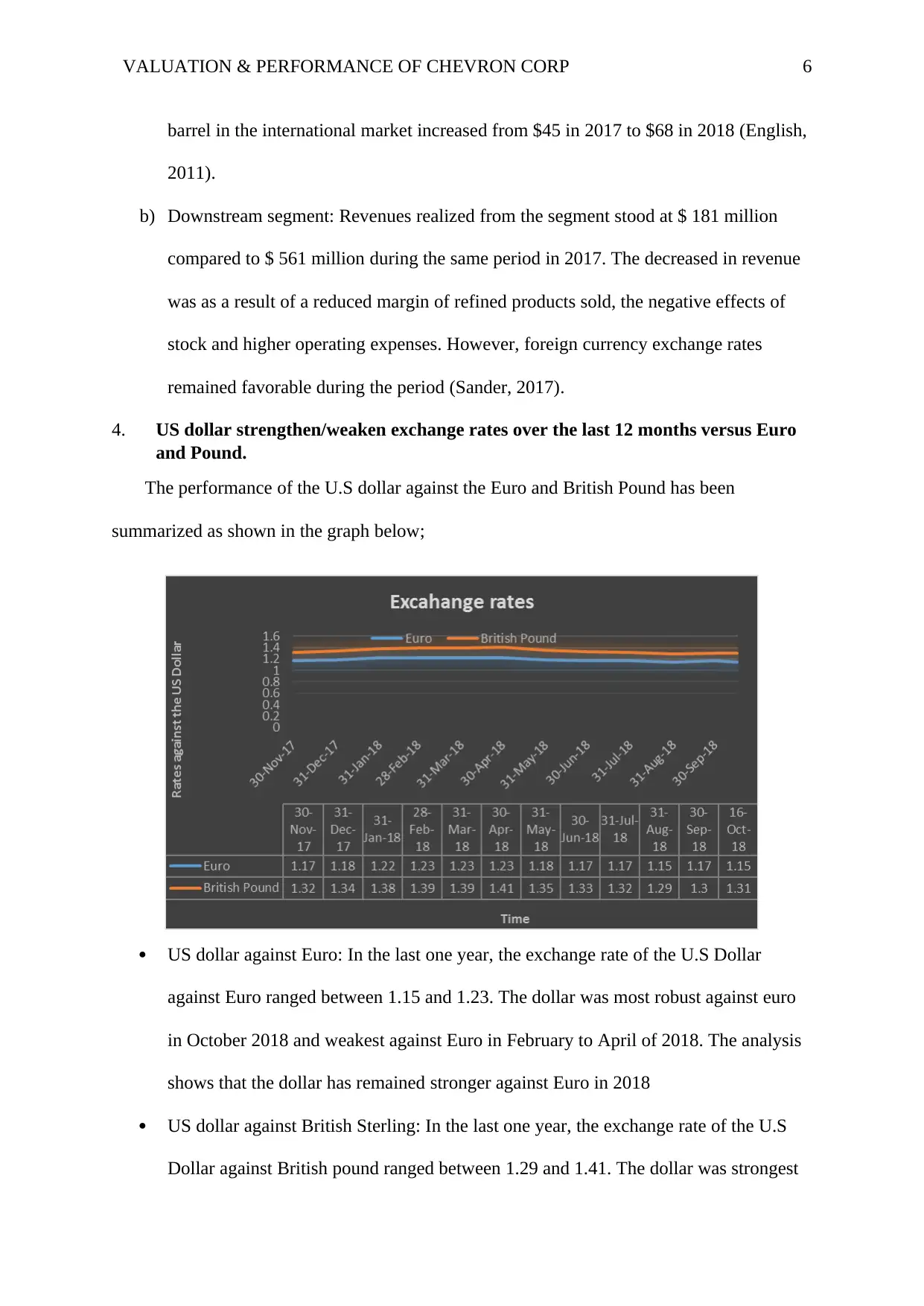
VALUATION & PERFORMANCE OF CHEVRON CORP 6
barrel in the international market increased from $45 in 2017 to $68 in 2018 (English,
2011).
b) Downstream segment: Revenues realized from the segment stood at $ 181 million
compared to $ 561 million during the same period in 2017. The decreased in revenue
was as a result of a reduced margin of refined products sold, the negative effects of
stock and higher operating expenses. However, foreign currency exchange rates
remained favorable during the period (Sander, 2017).
4. US dollar strengthen/weaken exchange rates over the last 12 months versus Euro
and Pound.
The performance of the U.S dollar against the Euro and British Pound has been
summarized as shown in the graph below;
US dollar against Euro: In the last one year, the exchange rate of the U.S Dollar
against Euro ranged between 1.15 and 1.23. The dollar was most robust against euro
in October 2018 and weakest against Euro in February to April of 2018. The analysis
shows that the dollar has remained stronger against Euro in 2018
US dollar against British Sterling: In the last one year, the exchange rate of the U.S
Dollar against British pound ranged between 1.29 and 1.41. The dollar was strongest
barrel in the international market increased from $45 in 2017 to $68 in 2018 (English,
2011).
b) Downstream segment: Revenues realized from the segment stood at $ 181 million
compared to $ 561 million during the same period in 2017. The decreased in revenue
was as a result of a reduced margin of refined products sold, the negative effects of
stock and higher operating expenses. However, foreign currency exchange rates
remained favorable during the period (Sander, 2017).
4. US dollar strengthen/weaken exchange rates over the last 12 months versus Euro
and Pound.
The performance of the U.S dollar against the Euro and British Pound has been
summarized as shown in the graph below;
US dollar against Euro: In the last one year, the exchange rate of the U.S Dollar
against Euro ranged between 1.15 and 1.23. The dollar was most robust against euro
in October 2018 and weakest against Euro in February to April of 2018. The analysis
shows that the dollar has remained stronger against Euro in 2018
US dollar against British Sterling: In the last one year, the exchange rate of the U.S
Dollar against British pound ranged between 1.29 and 1.41. The dollar was strongest

VALUATION & PERFORMANCE OF CHEVRON CORP 7
against the pound in August 2018 and weakest against British in April of 2018. The
analysis shows that the dollar has remained stronger against Pound in 2018
In the last quarter of 2017, the performance of the U.S dollar against other international
currencies signified fading of the country's economy. The International Monetary Fund (IMF)
downgraded the performance of the U.S economy from 2.5% to 2.1%. However, the
exchange rate analysis in 2018 shows that the economy is rebounding back. Following the
decision by President Donald Trump to reduce corporate tax from 35% to 20%, the U.S
companies and citizens are repatriating funds that had been held in foreign economies. The
move has increased the demand for US dollar, increased domestic investment which in return
boost economic growth. The U.S dollar is expected to strengthen further against the Euro and
the British pound.
5. How Chevron tried to manage its exposure to exchange rate risk
Exchange exposures are categorized into the transaction, economic and translation.
First, Chevron is exposed to transaction exchange risks whenever it engages in a contract
whose cash flows are likely to be affected by exchange rates from foreign currencies. For
example, Chevron has to exchange the cash flow realized from foreign trades into domestic
currency (the U.S dollar). Chevron engages in negotiating contracts with its international
partners. The negotiations entail setting delivery dates and prices. With the volatility in the
foreign exchange markets, the rates keep on changing which exposes the company to
transaction risks between US dollar and other foreign currencies (Statistica, 2018).
Second, economic exposure arises from the degree at which normal fluctuations in the
foreign currencies influence a firm's value. Economic exposure influences Chevron's value
and future cash flows relative to its competitors. For example, when exchange the U.S dollar
becomes stronger against the Euro, the demand in the EU petroleum product market is likely
against the pound in August 2018 and weakest against British in April of 2018. The
analysis shows that the dollar has remained stronger against Pound in 2018
In the last quarter of 2017, the performance of the U.S dollar against other international
currencies signified fading of the country's economy. The International Monetary Fund (IMF)
downgraded the performance of the U.S economy from 2.5% to 2.1%. However, the
exchange rate analysis in 2018 shows that the economy is rebounding back. Following the
decision by President Donald Trump to reduce corporate tax from 35% to 20%, the U.S
companies and citizens are repatriating funds that had been held in foreign economies. The
move has increased the demand for US dollar, increased domestic investment which in return
boost economic growth. The U.S dollar is expected to strengthen further against the Euro and
the British pound.
5. How Chevron tried to manage its exposure to exchange rate risk
Exchange exposures are categorized into the transaction, economic and translation.
First, Chevron is exposed to transaction exchange risks whenever it engages in a contract
whose cash flows are likely to be affected by exchange rates from foreign currencies. For
example, Chevron has to exchange the cash flow realized from foreign trades into domestic
currency (the U.S dollar). Chevron engages in negotiating contracts with its international
partners. The negotiations entail setting delivery dates and prices. With the volatility in the
foreign exchange markets, the rates keep on changing which exposes the company to
transaction risks between US dollar and other foreign currencies (Statistica, 2018).
Second, economic exposure arises from the degree at which normal fluctuations in the
foreign currencies influence a firm's value. Economic exposure influences Chevron's value
and future cash flows relative to its competitors. For example, when exchange the U.S dollar
becomes stronger against the Euro, the demand in the EU petroleum product market is likely
Paraphrase This Document
Need a fresh take? Get an instant paraphrase of this document with our AI Paraphraser
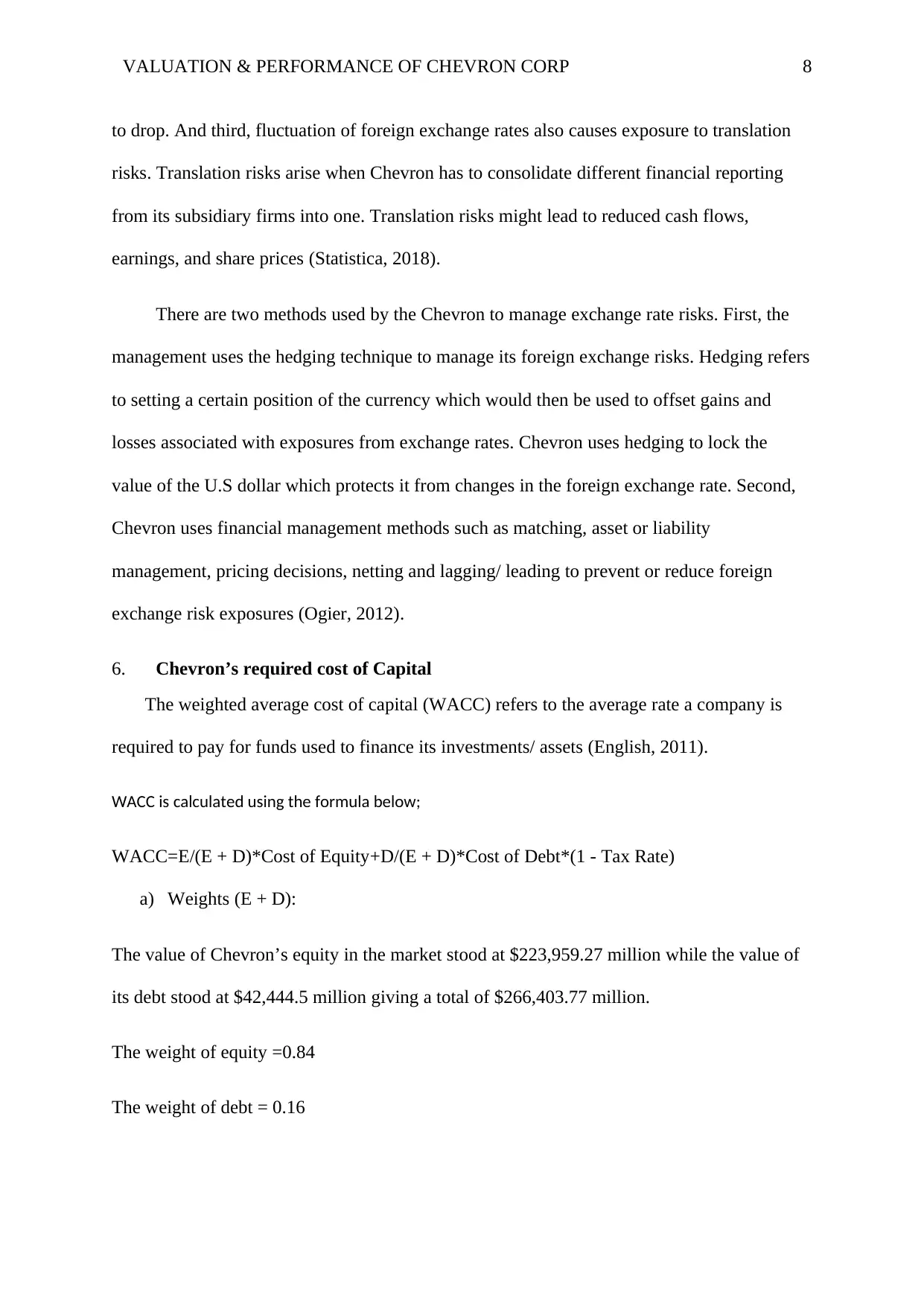
VALUATION & PERFORMANCE OF CHEVRON CORP 8
to drop. And third, fluctuation of foreign exchange rates also causes exposure to translation
risks. Translation risks arise when Chevron has to consolidate different financial reporting
from its subsidiary firms into one. Translation risks might lead to reduced cash flows,
earnings, and share prices (Statistica, 2018).
There are two methods used by the Chevron to manage exchange rate risks. First, the
management uses the hedging technique to manage its foreign exchange risks. Hedging refers
to setting a certain position of the currency which would then be used to offset gains and
losses associated with exposures from exchange rates. Chevron uses hedging to lock the
value of the U.S dollar which protects it from changes in the foreign exchange rate. Second,
Chevron uses financial management methods such as matching, asset or liability
management, pricing decisions, netting and lagging/ leading to prevent or reduce foreign
exchange risk exposures (Ogier, 2012).
6. Chevron’s required cost of Capital
The weighted average cost of capital (WACC) refers to the average rate a company is
required to pay for funds used to finance its investments/ assets (English, 2011).
WACC is calculated using the formula below;
WACC=E/(E + D)*Cost of Equity+D/(E + D)*Cost of Debt*(1 - Tax Rate)
a) Weights (E + D):
The value of Chevron’s equity in the market stood at $223,959.27 million while the value of
its debt stood at $42,444.5 million giving a total of $266,403.77 million.
The weight of equity =0.84
The weight of debt = 0.16
to drop. And third, fluctuation of foreign exchange rates also causes exposure to translation
risks. Translation risks arise when Chevron has to consolidate different financial reporting
from its subsidiary firms into one. Translation risks might lead to reduced cash flows,
earnings, and share prices (Statistica, 2018).
There are two methods used by the Chevron to manage exchange rate risks. First, the
management uses the hedging technique to manage its foreign exchange risks. Hedging refers
to setting a certain position of the currency which would then be used to offset gains and
losses associated with exposures from exchange rates. Chevron uses hedging to lock the
value of the U.S dollar which protects it from changes in the foreign exchange rate. Second,
Chevron uses financial management methods such as matching, asset or liability
management, pricing decisions, netting and lagging/ leading to prevent or reduce foreign
exchange risk exposures (Ogier, 2012).
6. Chevron’s required cost of Capital
The weighted average cost of capital (WACC) refers to the average rate a company is
required to pay for funds used to finance its investments/ assets (English, 2011).
WACC is calculated using the formula below;
WACC=E/(E + D)*Cost of Equity+D/(E + D)*Cost of Debt*(1 - Tax Rate)
a) Weights (E + D):
The value of Chevron’s equity in the market stood at $223,959.27 million while the value of
its debt stood at $42,444.5 million giving a total of $266,403.77 million.
The weight of equity =0.84
The weight of debt = 0.16
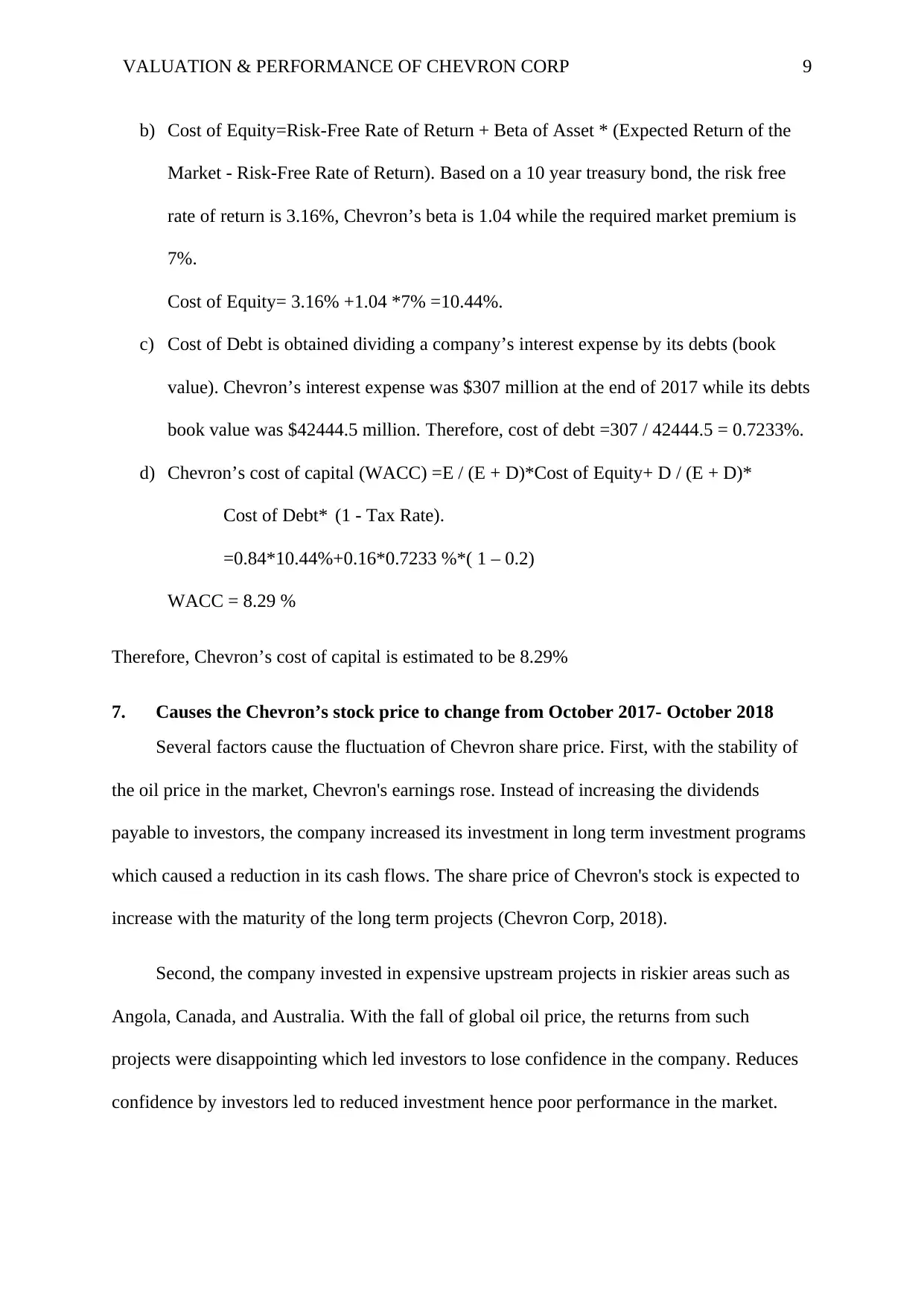
VALUATION & PERFORMANCE OF CHEVRON CORP 9
b) Cost of Equity=Risk-Free Rate of Return + Beta of Asset * (Expected Return of the
Market - Risk-Free Rate of Return). Based on a 10 year treasury bond, the risk free
rate of return is 3.16%, Chevron’s beta is 1.04 while the required market premium is
7%.
Cost of Equity= 3.16% +1.04 *7% =10.44%.
c) Cost of Debt is obtained dividing a company’s interest expense by its debts (book
value). Chevron’s interest expense was $307 million at the end of 2017 while its debts
book value was $42444.5 million. Therefore, cost of debt =307 / 42444.5 = 0.7233%.
d) Chevron’s cost of capital (WACC) =E / (E + D)*Cost of Equity+ D / (E + D)*
Cost of Debt* (1 - Tax Rate).
=0.84*10.44%+0.16*0.7233 %*( 1 – 0.2)
WACC = 8.29 %
Therefore, Chevron’s cost of capital is estimated to be 8.29%
7. Causes the Chevron’s stock price to change from October 2017- October 2018
Several factors cause the fluctuation of Chevron share price. First, with the stability of
the oil price in the market, Chevron's earnings rose. Instead of increasing the dividends
payable to investors, the company increased its investment in long term investment programs
which caused a reduction in its cash flows. The share price of Chevron's stock is expected to
increase with the maturity of the long term projects (Chevron Corp, 2018).
Second, the company invested in expensive upstream projects in riskier areas such as
Angola, Canada, and Australia. With the fall of global oil price, the returns from such
projects were disappointing which led investors to lose confidence in the company. Reduces
confidence by investors led to reduced investment hence poor performance in the market.
b) Cost of Equity=Risk-Free Rate of Return + Beta of Asset * (Expected Return of the
Market - Risk-Free Rate of Return). Based on a 10 year treasury bond, the risk free
rate of return is 3.16%, Chevron’s beta is 1.04 while the required market premium is
7%.
Cost of Equity= 3.16% +1.04 *7% =10.44%.
c) Cost of Debt is obtained dividing a company’s interest expense by its debts (book
value). Chevron’s interest expense was $307 million at the end of 2017 while its debts
book value was $42444.5 million. Therefore, cost of debt =307 / 42444.5 = 0.7233%.
d) Chevron’s cost of capital (WACC) =E / (E + D)*Cost of Equity+ D / (E + D)*
Cost of Debt* (1 - Tax Rate).
=0.84*10.44%+0.16*0.7233 %*( 1 – 0.2)
WACC = 8.29 %
Therefore, Chevron’s cost of capital is estimated to be 8.29%
7. Causes the Chevron’s stock price to change from October 2017- October 2018
Several factors cause the fluctuation of Chevron share price. First, with the stability of
the oil price in the market, Chevron's earnings rose. Instead of increasing the dividends
payable to investors, the company increased its investment in long term investment programs
which caused a reduction in its cash flows. The share price of Chevron's stock is expected to
increase with the maturity of the long term projects (Chevron Corp, 2018).
Second, the company invested in expensive upstream projects in riskier areas such as
Angola, Canada, and Australia. With the fall of global oil price, the returns from such
projects were disappointing which led investors to lose confidence in the company. Reduces
confidence by investors led to reduced investment hence poor performance in the market.
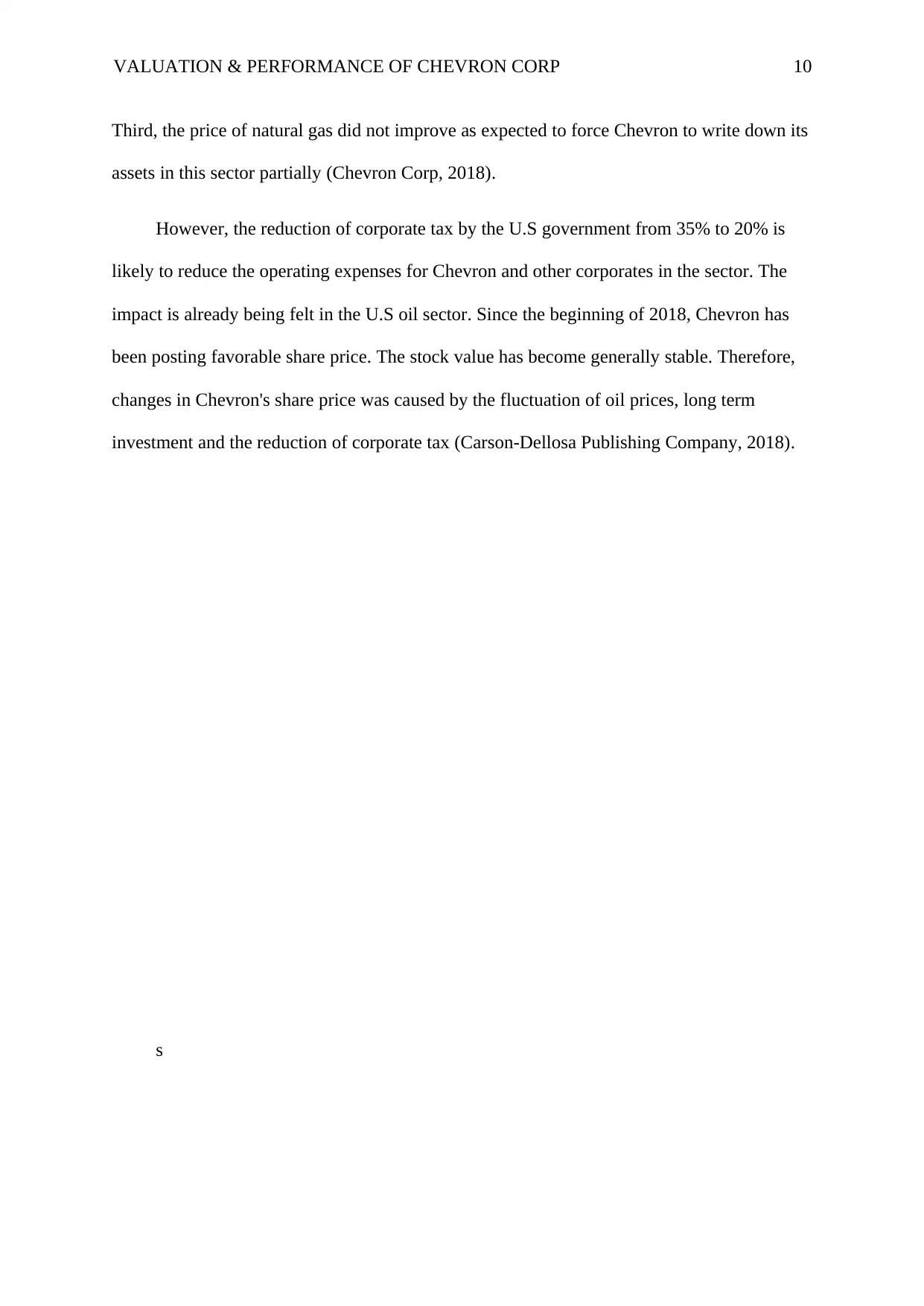
VALUATION & PERFORMANCE OF CHEVRON CORP 10
Third, the price of natural gas did not improve as expected to force Chevron to write down its
assets in this sector partially (Chevron Corp, 2018).
However, the reduction of corporate tax by the U.S government from 35% to 20% is
likely to reduce the operating expenses for Chevron and other corporates in the sector. The
impact is already being felt in the U.S oil sector. Since the beginning of 2018, Chevron has
been posting favorable share price. The stock value has become generally stable. Therefore,
changes in Chevron's share price was caused by the fluctuation of oil prices, long term
investment and the reduction of corporate tax (Carson-Dellosa Publishing Company, 2018).
s
Third, the price of natural gas did not improve as expected to force Chevron to write down its
assets in this sector partially (Chevron Corp, 2018).
However, the reduction of corporate tax by the U.S government from 35% to 20% is
likely to reduce the operating expenses for Chevron and other corporates in the sector. The
impact is already being felt in the U.S oil sector. Since the beginning of 2018, Chevron has
been posting favorable share price. The stock value has become generally stable. Therefore,
changes in Chevron's share price was caused by the fluctuation of oil prices, long term
investment and the reduction of corporate tax (Carson-Dellosa Publishing Company, 2018).
s
Secure Best Marks with AI Grader
Need help grading? Try our AI Grader for instant feedback on your assignments.
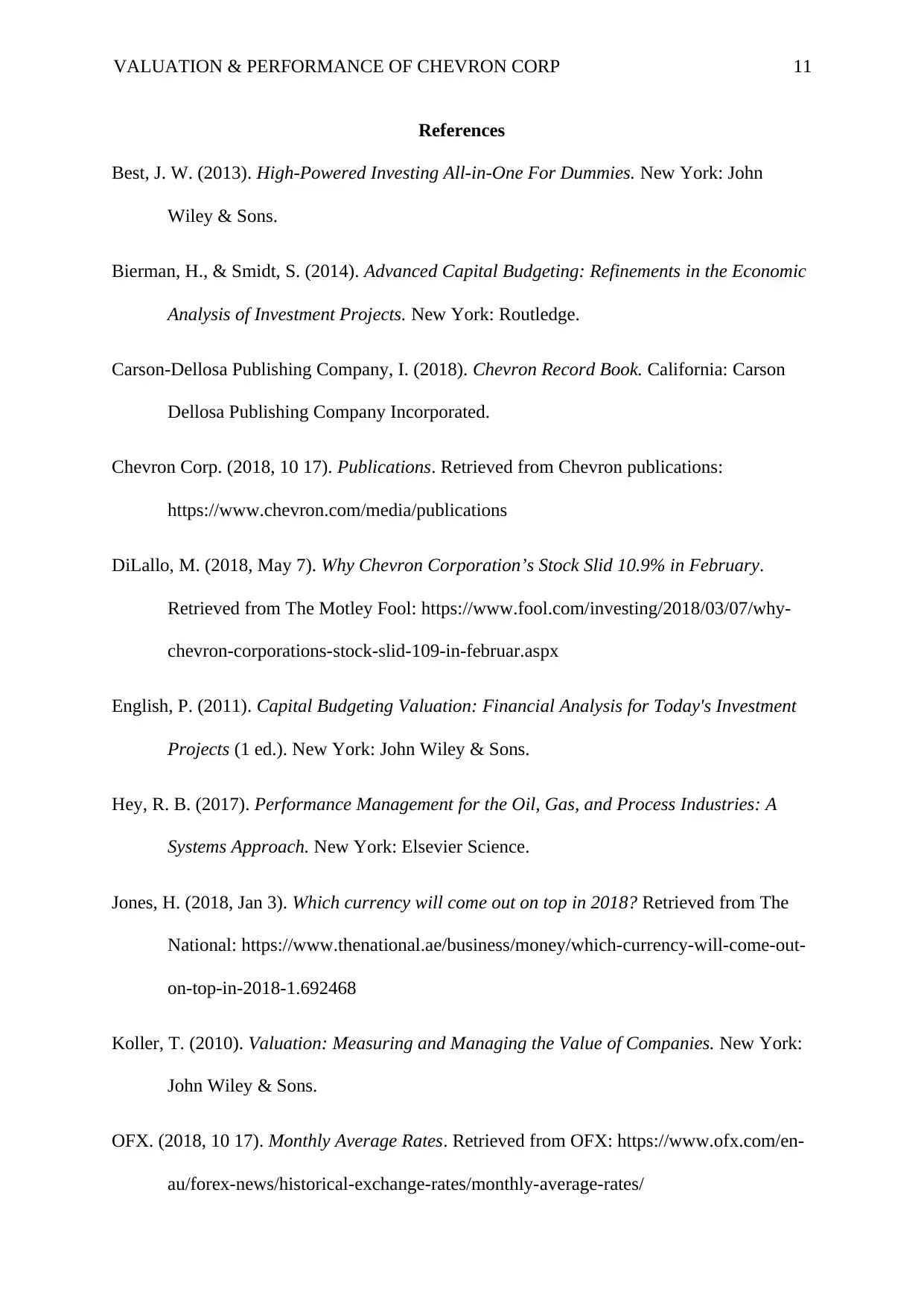
VALUATION & PERFORMANCE OF CHEVRON CORP 11
References
Best, J. W. (2013). High-Powered Investing All-in-One For Dummies. New York: John
Wiley & Sons.
Bierman, H., & Smidt, S. (2014). Advanced Capital Budgeting: Refinements in the Economic
Analysis of Investment Projects. New York: Routledge.
Carson-Dellosa Publishing Company, I. (2018). Chevron Record Book. California: Carson
Dellosa Publishing Company Incorporated.
Chevron Corp. (2018, 10 17). Publications. Retrieved from Chevron publications:
https://www.chevron.com/media/publications
DiLallo, M. (2018, May 7). Why Chevron Corporation’s Stock Slid 10.9% in February.
Retrieved from The Motley Fool: https://www.fool.com/investing/2018/03/07/why-
chevron-corporations-stock-slid-109-in-februar.aspx
English, P. (2011). Capital Budgeting Valuation: Financial Analysis for Today's Investment
Projects (1 ed.). New York: John Wiley & Sons.
Hey, R. B. (2017). Performance Management for the Oil, Gas, and Process Industries: A
Systems Approach. New York: Elsevier Science.
Jones, H. (2018, Jan 3). Which currency will come out on top in 2018? Retrieved from The
National: https://www.thenational.ae/business/money/which-currency-will-come-out-
on-top-in-2018-1.692468
Koller, T. (2010). Valuation: Measuring and Managing the Value of Companies. New York:
John Wiley & Sons.
OFX. (2018, 10 17). Monthly Average Rates. Retrieved from OFX: https://www.ofx.com/en-
au/forex-news/historical-exchange-rates/monthly-average-rates/
References
Best, J. W. (2013). High-Powered Investing All-in-One For Dummies. New York: John
Wiley & Sons.
Bierman, H., & Smidt, S. (2014). Advanced Capital Budgeting: Refinements in the Economic
Analysis of Investment Projects. New York: Routledge.
Carson-Dellosa Publishing Company, I. (2018). Chevron Record Book. California: Carson
Dellosa Publishing Company Incorporated.
Chevron Corp. (2018, 10 17). Publications. Retrieved from Chevron publications:
https://www.chevron.com/media/publications
DiLallo, M. (2018, May 7). Why Chevron Corporation’s Stock Slid 10.9% in February.
Retrieved from The Motley Fool: https://www.fool.com/investing/2018/03/07/why-
chevron-corporations-stock-slid-109-in-februar.aspx
English, P. (2011). Capital Budgeting Valuation: Financial Analysis for Today's Investment
Projects (1 ed.). New York: John Wiley & Sons.
Hey, R. B. (2017). Performance Management for the Oil, Gas, and Process Industries: A
Systems Approach. New York: Elsevier Science.
Jones, H. (2018, Jan 3). Which currency will come out on top in 2018? Retrieved from The
National: https://www.thenational.ae/business/money/which-currency-will-come-out-
on-top-in-2018-1.692468
Koller, T. (2010). Valuation: Measuring and Managing the Value of Companies. New York:
John Wiley & Sons.
OFX. (2018, 10 17). Monthly Average Rates. Retrieved from OFX: https://www.ofx.com/en-
au/forex-news/historical-exchange-rates/monthly-average-rates/

VALUATION & PERFORMANCE OF CHEVRON CORP 12
Ogier, T. (2012). The Real Cost of Capital: A Business Field Guide to Better Financial
Decisions. London: Pearson.
Ramon, S. (2018, July 27). Chevron Reports Second Quarter Net Income of $3.4 Billion.
Retrieved from Financial Times: https://markets.ft.com/data/announce/detail?
dockey=600-201807270830BIZWIRE_USPRX____BW5089-1
Sander, P. (2017). The 100 Best Stocks to Buy in 2018. New York: Simon and Schuster.
Statistica. (2018, 10 17). Euro (EUR) to U.S. dollar (USD) monthly exchange rate from
September 2016 to September 2018. Retrieved from The Statistics Portal:
https://www.statista.com/statistics/438061/euro-to-us-dollar-monthly-exchange-rate/
Ogier, T. (2012). The Real Cost of Capital: A Business Field Guide to Better Financial
Decisions. London: Pearson.
Ramon, S. (2018, July 27). Chevron Reports Second Quarter Net Income of $3.4 Billion.
Retrieved from Financial Times: https://markets.ft.com/data/announce/detail?
dockey=600-201807270830BIZWIRE_USPRX____BW5089-1
Sander, P. (2017). The 100 Best Stocks to Buy in 2018. New York: Simon and Schuster.
Statistica. (2018, 10 17). Euro (EUR) to U.S. dollar (USD) monthly exchange rate from
September 2016 to September 2018. Retrieved from The Statistics Portal:
https://www.statista.com/statistics/438061/euro-to-us-dollar-monthly-exchange-rate/
1 out of 12
Your All-in-One AI-Powered Toolkit for Academic Success.
+13062052269
info@desklib.com
Available 24*7 on WhatsApp / Email
![[object Object]](/_next/static/media/star-bottom.7253800d.svg)
Unlock your academic potential
© 2024 | Zucol Services PVT LTD | All rights reserved.